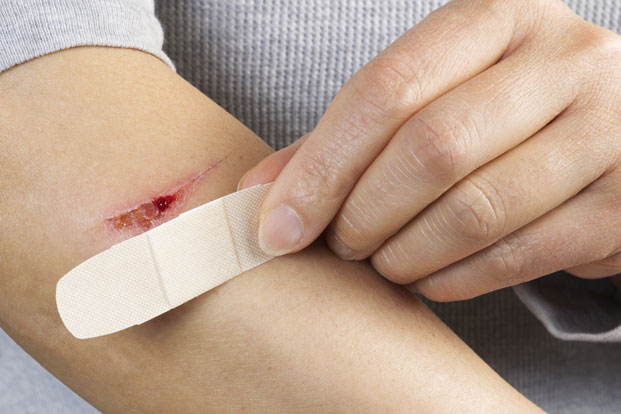If you’re a typically active person, at some point in your life you will have a break in the skin. This can be caused by a scratch from an object, a scrape from falling, a cut from a rusty nail, a knife slip when preparing food, an animal bite or perhaps an automobile accident.
However the wound is acquired, it’s important to treat the affected area in short order to prevent infection, which can cause a host of additional problems for the afflicted.
Most wounds are susceptible to bacteria contamination. But wounds become infected when the immune system is overwhelmed by bacteria growth and the bacteria have colonized. The result is the wound failing to heal or getting worse.
Infection is a health problem but particularly so if it occurs as a result of surgery. It is estimated that 70 percent of surgical deaths are caused by infections at the incision site.
Most infected wounds are caused by bacteria transferring from the skin, the outside environment or other parts of the body. The skin normally contains harmless bacteria if the skin is not penetrated. However, when a wound breaks the skin, the protective barrier is ruptured, allowing the bacteria to colonize the interior. This causes inflammation, which delays healing and may further damage the tissue, plus extreme pain, swelling, redness, pus discharge, and sometimes a foul odor. Staphylococcus aureus is the most common bacteria found in wound infections.
Dressing Is Key
Infections sometimes can occur because the wound was improperly dressed under unsanitary conditions, allowing dirt to infiltrate the wound. They also can occur in people with compromised immune systems, like the elderly or diabetics, who can’t easily fight off the encroaching bacteria.
Once infected, complications stemming from the infection can multiply. The wound will not heal and will cause severe pain. It may spread to surrounding tissues, creating a skin infection or a bone infection, known as osteomyelitis. If the infection gets into the bloodstream, other areas of the body may become infected, creating a system-wide problem.
Note that not all infections occur at the surface. It is possible for a cut to become infected deep inside the wound without any prominent signs at the spot of the puncture. However, the pain and swelling will be felt inside the wound, and a pus pocket (called an abscess) may form deep in the wound. This may require surgical intervention or intravenous antibiotic treatments.
When to Call the Doctor
A doctor should be consulted if a patient with a wound notices expanding redness in the wound area, green or yellow pus draining from the wound, a red streak spreading outward from the wound, swelling, tenderness in the immediate area, fever or extreme pain in the wound areas.
Wound healing thrives in moist (not wet) conditions to stimulate the cells that promote healing. Dressings on the wound should be replaced daily (twice a day is ideal) and the caregivers should be careful to make sure hands are clean, bandages are not dirty, any instruments touching the wound are sterilized and wound dressings are used to promote healing. Any antibiotics applied directly to the wound or taken orally should be done under a doctor’s direction. Intravenous antibiotics may be administered if a blood infection occurs as a result of the wound. This condition is known as sepsis and is potentially life-threatening.
Effective Wound Treatments
Small cuts and other minor skin tears are usually not a problem, and although a bandage and some ointment will help, they will heal fine on their own. Stop the bleeding, clean the area with warm water and soap, pat dry, and apply antiseptic ointment and a bandage to treat these minor cuts. Change the bandage daily, taking care not to pull off the scab forming over the cut.
Larger cuts or wounds require a more rigorous approach. A cut that spurts a lot of blood or one that will not stop bleeding after a reasonable amount of time and pressure may need a doctor’s attention. First, cover the wound with a sterile bandage or other clean item like a towel or gauze. Do not remove the original covering. If blood keeps soaking through, simply put a new bandage on top of the old one. Try to elevate the injured body part to slow the bleeding.
A large wound or one in which the edges are far apart may require a doctor, nurse or other medical professional to administer stitches. Using an anesthetic cream or, in some cases, a shot, the attending medical professional then will stitch together the wound in the same manner as sewing a coat together.
If you receive stitches, a follow-up visit to remove them is in order, unless they are the type that simply fall out on their own or are absorbed after a given period. An alternative to stitches is surgical glue or sterilized tape that will hold the wound together. Although a scar will be present in some cases, there are techniques that can minimize the scar if it’s in a prominent place on the body.
When a wound occurs from an animal or human bite, doctors usually administer antibiotics to stop the saliva germs from creating an infection. It’s also necessary for the medical professional to make sure the animal did not have rabies. You will also be asked if you know the date of your last tetanus shot. If you have not had one in the past year or so, you likely will receive one to minimize the chances of a tetanus infection.

Leave a Reply